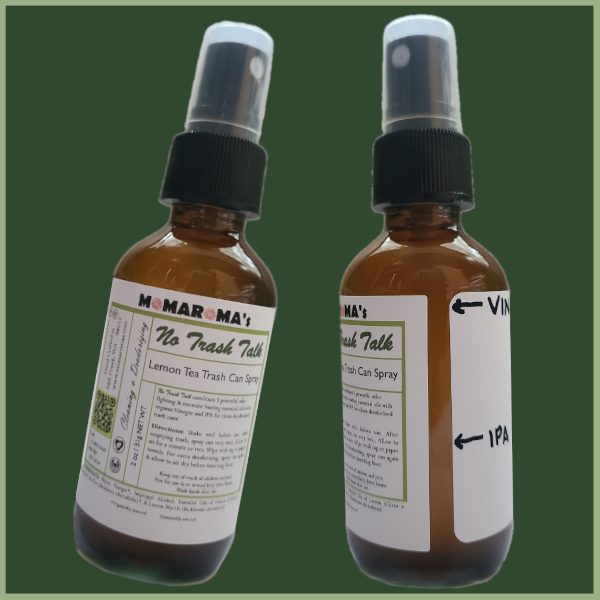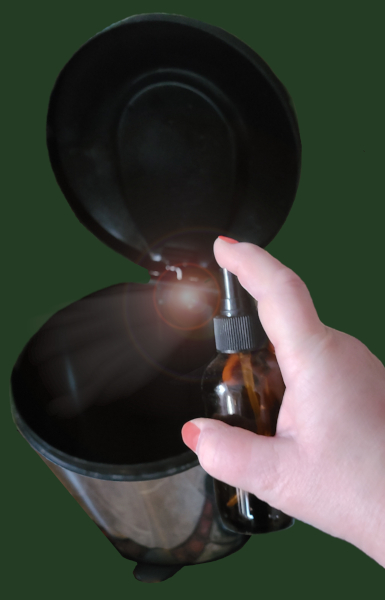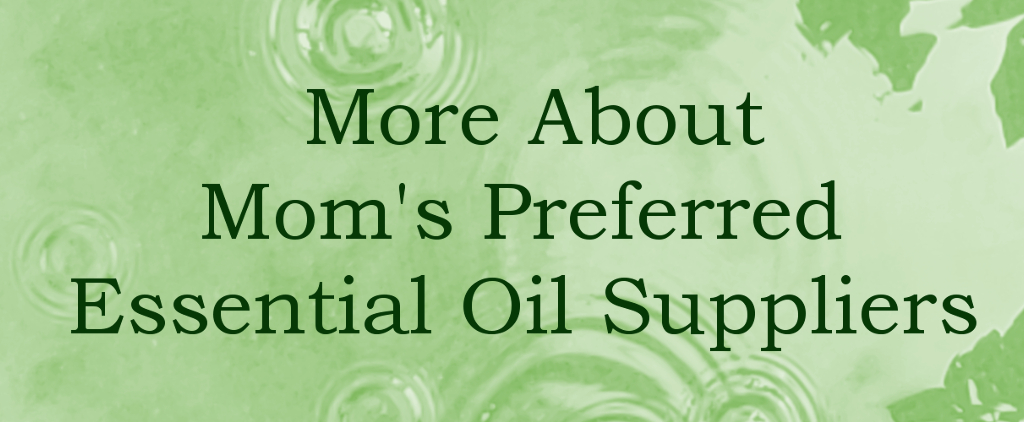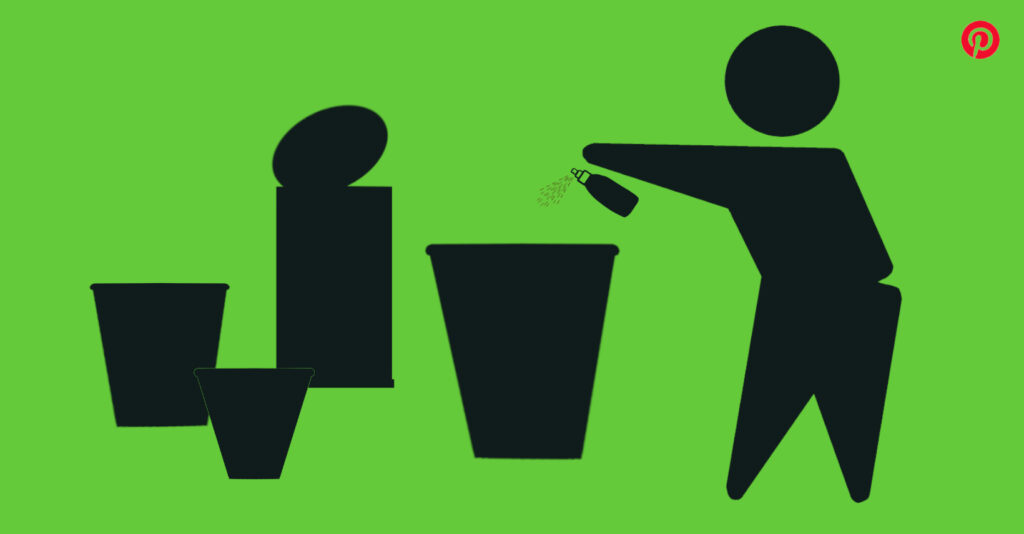
A Cleaning & Deodorizing Trash Spray in 10 Simple Steps!
The first green cleaning product I made was a trash spray for cleaning and deodorizing my kitchen and bathroom garbage cans. It was the beginning of a wonderful green cleaning adventure!
No Trash Talk garbage can spray harnesses the antimicrobial and deodorizing power of isopropyl alcohol, vinegar, and some of my favorite essential oils for green cleaning.

[This post contains affiliate links. If you make a purchase through one of these links I may earn a commission. This does not impact your price. For more information, please see our disclosure.]
In this Post:
⭐️No Trash Talk Garbage Can Spray Recipe
In the recipe, I provide weights and tablespoon measurements for each of the base ingredients, and tips for “eyeballing” it, too! When I make my green cleaning products I prefer to weigh the ingredients as I add them to the bottle—it makes for fewer dishes to clean!
- 2-ounce Spray Bottle (glass or PET plastic)
- 2 Tablespoons (20 grams) 70% Isopropyl Alcohol (IPA)
- 36-40 drops Essential Oil (suggestions below)
- 2 Tablespoons (20 grams) White Vinegar
- 1 Tablespoon or less Distilled Water
- Plus a small funnel, 2 Labels, and a Permanent Marker
🌺See my Recommended Suppliers below
Make Your Trash Spray
We’re going to make it super easy to make your second bottle of No Trash Talk! Before mixing up your trash can spray, affix a label lengthwise on the bottle. Then, as you measure each of the ingredients, mark the new level on the label with the permanent marker. I use this method with all my DIY green cleaning products!
💚PRO TIP: Using a small funnel helps reduce spillage.
- First, put the bottle on the scale, insert the funnel, and tare the scale.
- Add 2 Tablespoons (20 grams) Isopropyl Alcohol (mark the level).
- Eyeball: Just under half-way.
- Remove the funnel.
- Add your selected Essential Oils by drops to the bottle.
- Cap, shake well, and set aside for a minimum of 30 minutes (60 minutes is better).*
- Remove the cap, return the bottle to scale, insert the funnel, and tare the scale.
- Add 2 Tablespoons (20 grams) Vinegar (mark level).
- Eyeball: To just a touch under the shoulder
- Add distilled/filtered Water (about 1 Tablespoon) to reach the bottom of the bottle’s neck.
- Cap and shake well.
- And finally, affix a label with product name, ingredients, and instructions. Done!
*After adding the essential oils, this “set aside” time allows the alcohol to act as a solubilizer; it makes the essential oils more able to dissolve/be more soluble in water.
Using Your Trash Can Spray
Use your trash spray to clean and deodorize all your household garbage cans:
– Empty your garbage can.
– Give your trash can spray a good shake.
– Mist the entire can with trash spray.
– After a minute or two, wipe it clean with a rag or paper towel, making sure to get into the edges at the base of the can.
– Then, before inserting your trash can liner, mist the can again for additional deodorizing and germ fighting.
– If you have a garbage can with a lid, give the lid a spray and wipe down, too!
– Wash hands after using any cleaning product.

Trash Spray Essential Oil Blends
Okay (rubs hand together) let the fun begin! For our trash can spray, we’re going to take advantage of the essential oils with excellent antimicrobial and deodorizing properties. Here are a few blends to get you started—feel free to mix and match these essential oils in all your green cleaning products!
💚Pro Tip: Please wear gloves when using essential oils. If undiluted essential oil gets on your skin, apply a lipid carrier oil, like Jojoba, then wash well with soap and water.
🌺See my Recommended Suppliers below
⭐️Favorite Lemon Tea Blend
- 18 drops Lemon essential oil (Citrus x limon)
- 12 drops Tea Tree essential oil (Melaleuca alternifolia)
- 6 drops Lemon Myrtle essential oil (Backhousia citriodora)
⭐️Clean Citrus Blend
- 16 drops Sweet Orange essential oil (Citrus x sinensis)
- 12 drops Lemongrass essential oil (Cymbopogon citratus/C. flexuosus)
- 8 drops Lime essential oil (Citrus x aurantifolia)
⭐️Fresh Evergreen Blend
- 15 drops Siberian Fir essential oil (Abies siberica)
- 15 drops Douglas Fir essential oil (Pseudotsuga menziesii)
- 10 drops Hemlock essential oil (Tsuga canadensis)
⭐️Spicy Blend
- 3 drops Laurel Leaf essential oil (Laurus nobilis)
- 2 drops Clove Bud essential oil (Eugenia caryophyllata)
- 2 drops Sweet Orange essential oil (Citrus x sinensis)
- 1 drop Cinnamon Bark essential oil (Cinnamomum cassia/C. zeylanicum)
Do you have a favorite essential oil blend you use for green cleaning? Please share in the comments below!

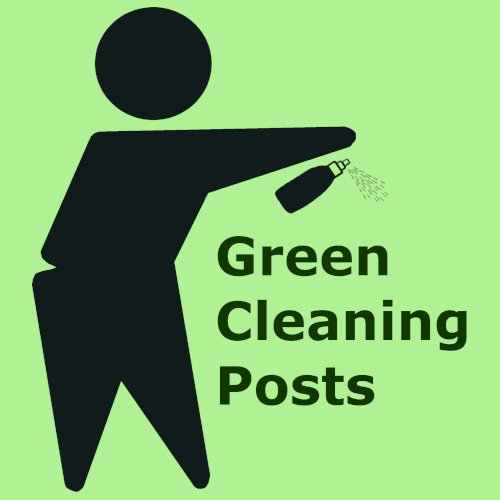
📌Green Cleaning Pins

Mom’s Shopping List
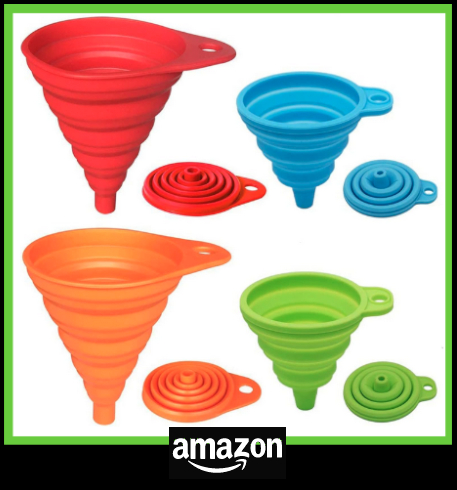
White vinegar, 70% isopropyl alcohol, and distilled water are staples of my green cleaning product closet. I pick them up at my local grocer.
And here are the suppliers I use for the essential oils in these No Trash Talk blends.
Favorite Lemon Tea Blend
- Lemon essential oil (Citrus x limon):
- Aromatics International, organic
- Edens Garden, sustainable (on Amazon)
- Plant Therapy, organic (Direct and Amazon).
- Tea Tree essential oil (Melaleuca alternifolia):
- Aromatics International, organic
- Plant Therapy, organic (Direct and Amazon)
- TIP: Tea Tree Hydrosol is excellent for skin care!
- Lemon Myrtle essential oil (Backhousia citriodora):
- Aromatics International, organic (not currently available)
- Edens Garden, sustainable (Amazon)
- Plant Therapy, sustainable (Direct and Amazon).
Clean Citrus Blend
- Sweet Orange essential oil (Citrus x sinensis):
- Aromatics International, organic
- Plant Therapy, organic (Direct and Amazon).
- Lemongrass essential oil (Cymbopogon citratus / C. flexuosus):
- Aromatics International, sustainably wildcrafted
- Plant Therapy, organic (Direct and Amazon)
- Also Aromatics International’s skin-gentle, organic Lemongrass ct rhodinol.
- Lime essential oil (Citrus x aurantifolia):
- Aromatics International, organic, distilled💚
- Plant Therapy, sustainable, distilled (Direct and Amazon)
- Plant Therapy, sustainable, cold pressed (Direct and Amazon)
- Edens Garden, sustainable, cold pressed (on Amazon).
Fresh Evergreen Blend
- Siberian Fir essential oil (Abies siberica):
- Aromatics International, wildcrafted
- Plant Therapy, sustainable “Fir Needle” (Direct and Amazon).
- Douglas Fir essential oil (Pseudotsuga menziesii):
- Aromatics International, wildcrafted
- Plant Therapy, sustainable (Direct and Amazon).
- Hemlock essential oil (Tsuga canadensis):
- Aromatics International, organic.
Spicy Blend
- Laurel Leaf essential oil (Laurus nobilis):
- Aromatics International, organic
- Plant Therapy, sustainable (Direct and Amazon).
- Clove Bud essential oil (Eugenia caryophyllata/Syzygium aromaticum):
- Aromatics International, sustainably wildcrafted
- Plant Therapy, organic (Direct and Amazon).
- Sweet Orange essential oil (Citrus x sinensis):
- Aromatics International, organic
- Plant Therapy, organic (Direct and Amazon).
- Cinnamon Bark essential oil (Cinnamomum verum/C. zeylanicum/C. cassia):
- Aromatics International, organic
- Plant Therapy, organic (Direct and Amazon).
This information has not been evaluated by the Food and Drug Administration and is not intended to diagnose, treat, cure, or prevent any disease. It is for educational purposes only.
All recipes provided are for personal use and are not designed for re-sale or large-scale manufacturing.
Please consult your doctor, naturopath, herbal practitioner, or other qualified health professional for medical advice and before starting any herbal regimen, particularly if you are pregnant or nursing, have any existing medical conditions, or are taking any medications.

Chris P | Author, Certified Aromatherapist, Natural Skin Care Formulator
Chris (“Mom”) enjoys formulating bespoke aromatherapy, skin care, and herbal products to support her family, pets, friends, and clients. She also loves experimenting with recipes in the kitchen. An avid reader, writer, and lifetime learner, Chris enthusiastically explores research rabbit holes and then writes about her discoveries.💚 (Learn more >>)


